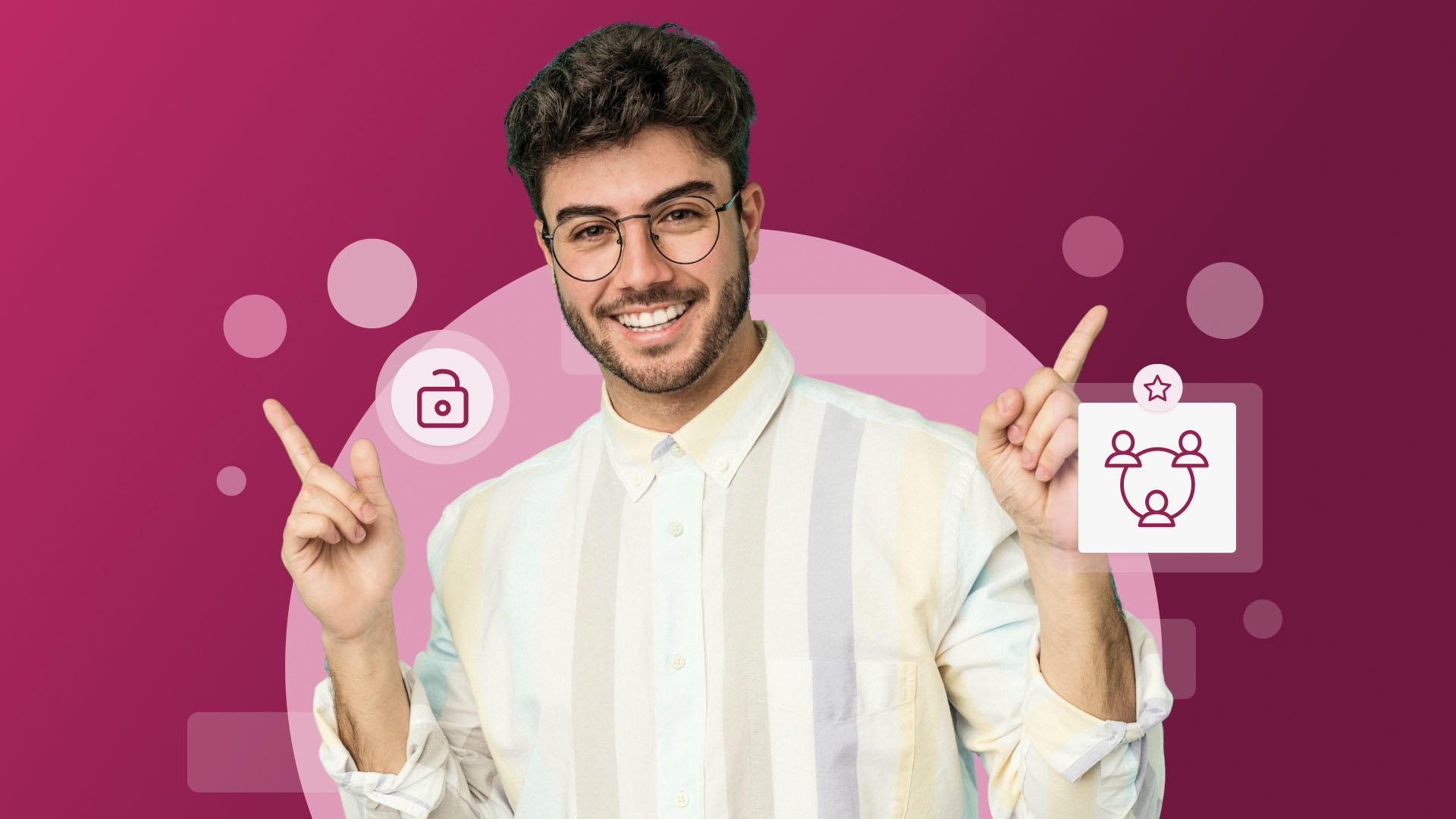How agencies can unlock client success with advanced audience segmentation
As a marketer, any time you go to run digital ads, we’re sure you feel annoyed or even shocked egmentation equals cby the cost to run those ads. This is thanks to the increased accessibility and demand for ad space.
The digital marketing landscape in 2024 has become so competitive that running ads that cut through the noise of all the other ads is practically impossible. To put things in perspective, people now see about 10,000 ads per day. That’s insane.
Even more insane is that 80% of these ads are still being targeted at the wrong audience, and around 23% of the 88 billion dollar yearly global ad spend is completely wasted.
This problem is costing brands money, and it’s costing agencies their clients.
This is why it has never been more important for agencies to get audience targeting right, the first time around, so that valuable ad spend isn’t thrown away on the wrong audiences. So what is a fool-proof method agencies should use to get targeting right, and drive client success? Audience segmentation.
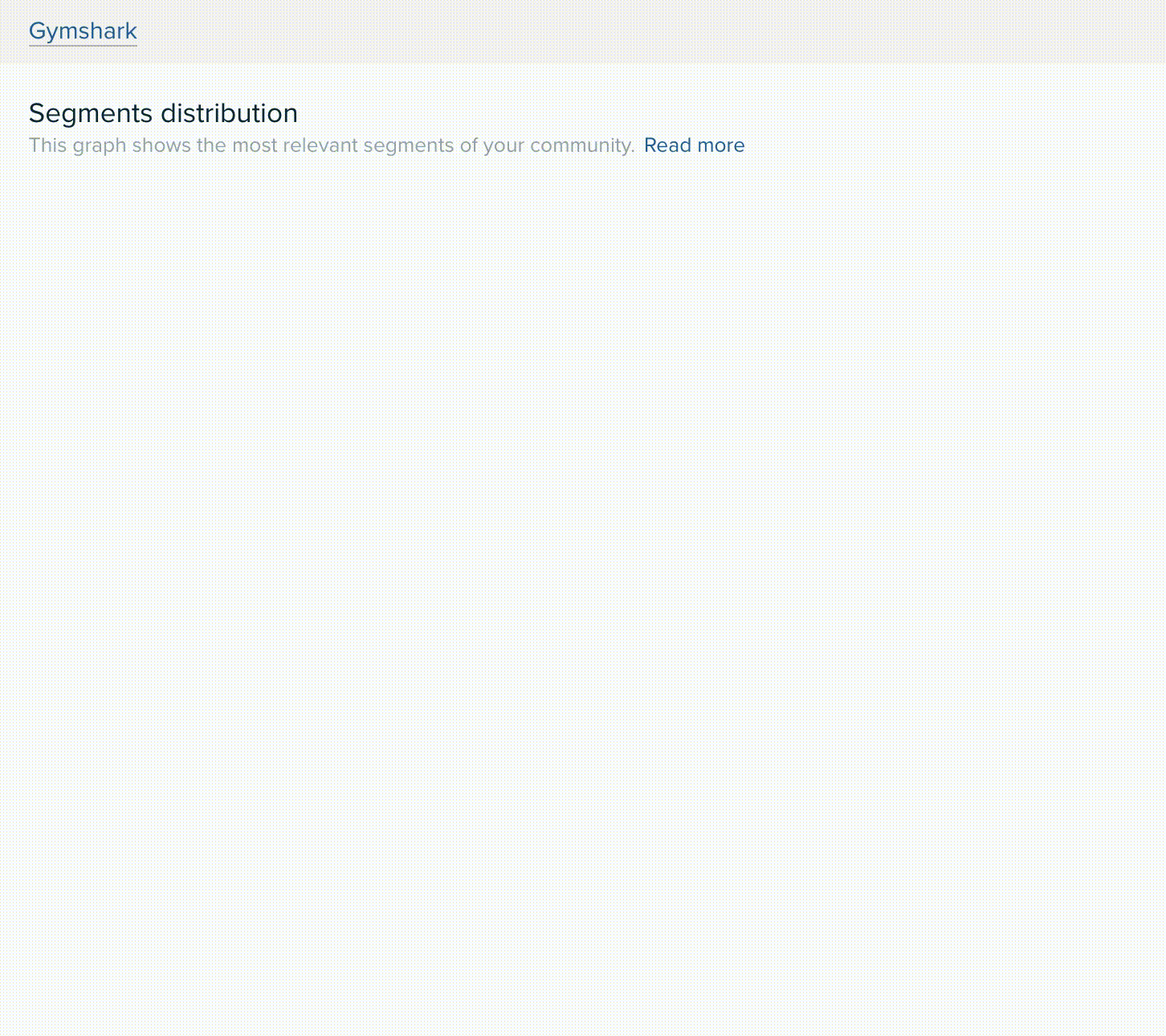
Segmentation equals campaign success
Audience segmentation is a game-changer for agencies when it comes to marketing campaigns, for several reasons.
The most obvious is that segmentation allows agencies to divide a large consumer group into smaller groups that can then be targeted with personalized and tailored marketing strategies.
Segmentation is what agencies need to build accurate customer personas that include the nitty gritty details, like which ad types have the most effect on that audience, or which copy will connect with them emotionally.
This practice of precise audience segmentation guarantees that ads resonate with the target audience, and it leads to higher engagement rates and ROI.
The best part is that the exercise of audience segmentation can surface segments your client may not even know exist, but pose an opportunity and should be targeted.
Segmentation can also highlight the segments that agencies should go after first, by outlining which specific segment shows the highest buyer internet and interest in the client’s brand.
With insights like these, agencies can allocate resources more efficiently by focusing on the more lucrative segments, and can avoid wasting client money targeting segments that will never become customers.
Finally, audience segmentation helps agencies build out target audiences on social ad platforms with precision. Segmentation with audience intelligence tools highlight those extra layers of insight that make the audience “build” way more accurately and it guarantees the ad will show up in front of the right audiences.
The old way to segment audiences
For most agencies, audience segmentation is nothing new, but they could be using old methods to segment their client's audience.
One of those methods includes segmenting audiences based on demographics. This means grouping people based on their age, gender, location, job title, and income level. This is extremely old-school and generic, yet it seems to be perceived as a fail-safe method for some agencies.
The problem is that this method doesn't reflect the key differences in customer behaviors, interests and needs, required to build ads that resonate.
The next method agencies use is segmentation based on perceived behaviors and needs. The issue is that this is based on human biases, and the result is that people end up in the same segment when they shouldn’t be.
The problem with both of these methods is that you don’t decide what segment a customer is in, they do. For example, a stay-at-home mom of four kids who likes horror films and rock music might have more in common interest-wise with a male Gen Z gamer, but if you build the segments based on your own criteria or biases, they would never get placed in the same segment.
It shouldn't be up to you, or anyone, to decide how segments are created, it should happen automatically and in an unbiased way.
Unbiased segmentation
A platform like Audiense is the best tool for segmenting your client’s audience because it uses unbiased segmentation.
What this means is that you can’t place any biases on how an audience will be segmented out. Instead, Audiense automatically and organically segments your audience based on their shared interests and behaviors - without using a preconceived notion of who the audience might be.
That’s how new “surprising” segments are uncovered and false audience narratives are squashed.
So how does it work? Let’s take a look.
How to properly segment an audience step-by-step
Step 1: Audience collection
The first step in audience segmentation is audience collection. Agencies must be able to collect their client’s audience data at a moment's notice, without needing access to their client’s first-party data or CRM systems.
Audiense makes it easy to build reports that collect audiences behind any brand instantly. To build a report all you have to do is select your client’s brand and the number of segments you want their audience to divided out into.
Below is an Audiense report that was built to collect the audience behind the Burt's Bee’s brand.
You can see just how easy it is to run a quick report on any brand audience, which is why this exercise is also perfect for building an agency pitch on the fly.
Step 2: Segmentation
Audiense takes your client’s audience and automatically segments into smaller groups based on their shared interests and behaviors. Because this is done automatically through machine learning, it removes any audience biases that could interfere with the segmentation. This method gives you an accurate picture of what these smaller segments within the larger audience look like.
The Burt's Bee’s audience was segmented into 14 unique segments. The members of each segment share the same interests and behaviors, making it easy to target these segments with campaigns that resonate with their shared qualities.
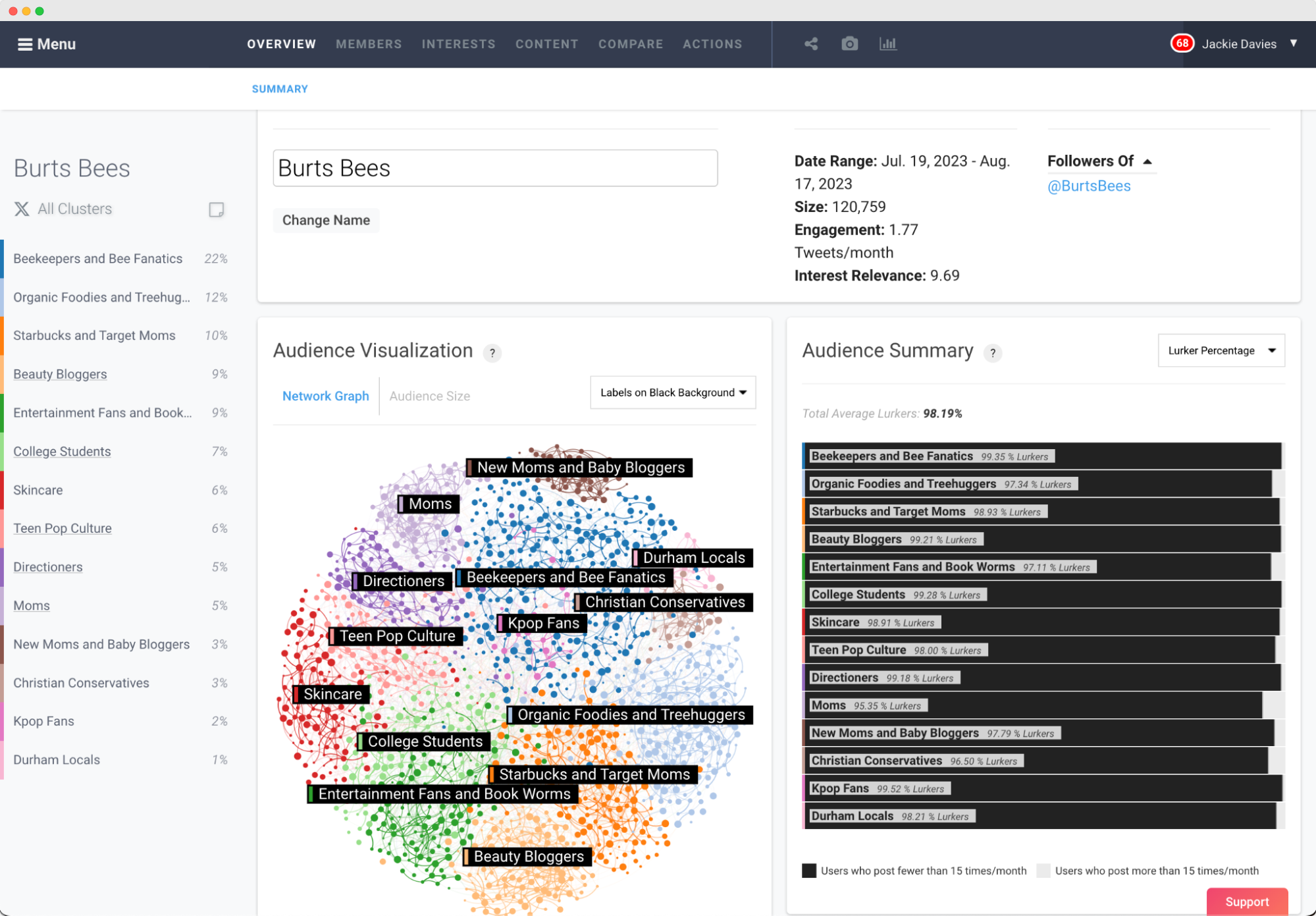
Step 3: Opportunity assessment
The beautiful part about unbiased segmentation is that segments could emerge that you had never considered. It’s a great way to unearth new opportunities and customers to target.
Now that the audience has been segmented, it’s time to highlight those new segments to your client and decide if you want to target them in your marketing campaign.
You can also get a feel for the segments that are more lucrative in terms of audience size and brand interest.
Based on these insights you can increase ad spend and target the segments you know are going to buy, and spend less on the smaller less lucrative segments.
In the Burt's Bees example, there was an unexpected “New Moms and Baby Bloggers” segment that emerged. This audience group uses Burt’s Bees as a chemical-free product for their babies. This poses a new opportunity for Burt's Bee’s to target this group with ads that feature a mom and her new baby, for example.
The “New Moms and Baby Bloggers” segment also shows the highest interest in the Burt's Bee’s brand overall. They might be a smaller segment but this audience is more likely to engage with the brand and make a purchase, so they are a great segment to target first.
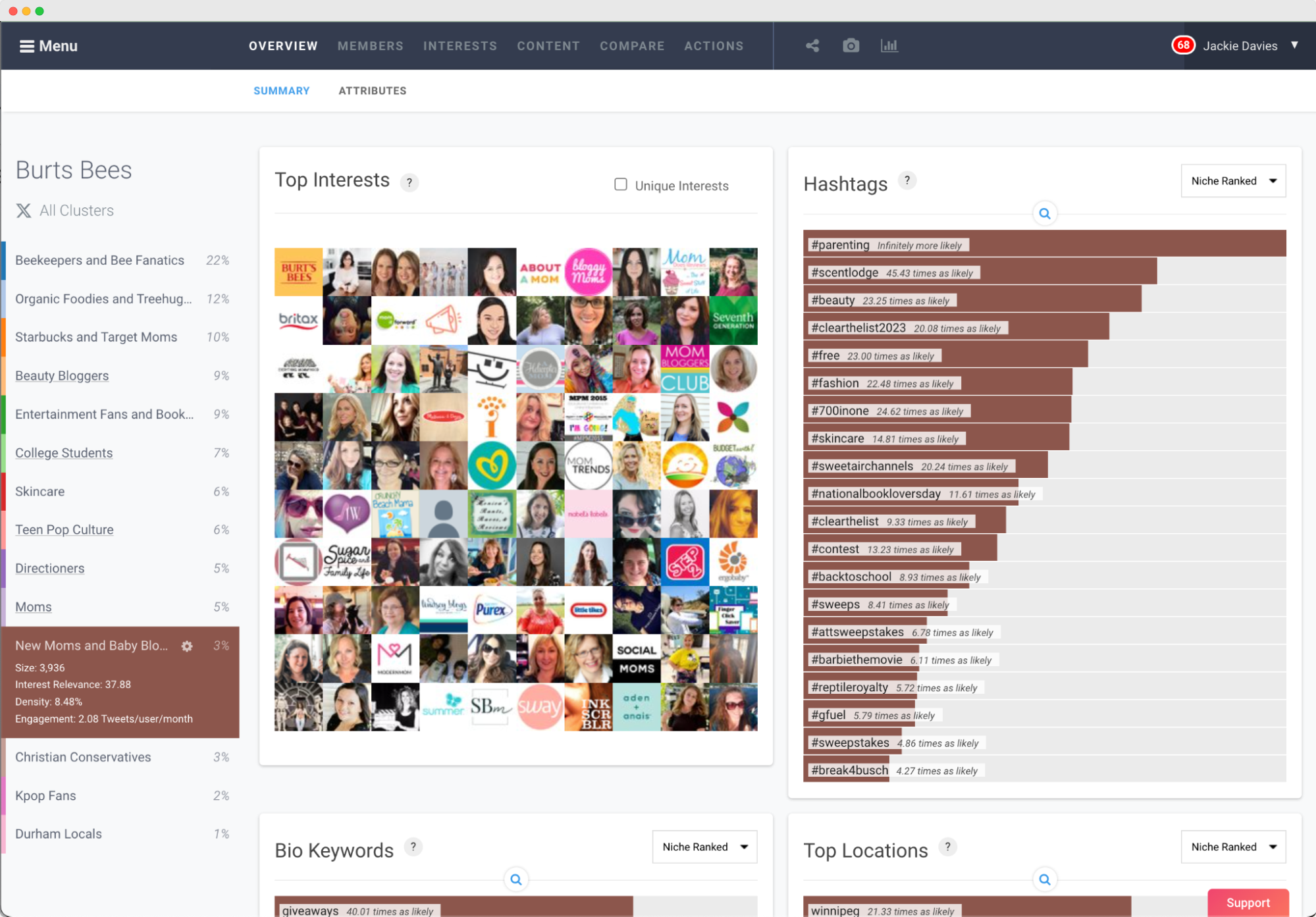
Step 4: Audience analysis
Once you and your client have chosen a segment to focus on and target in your next campaign, it’s time to dive into the report insights and get to know this audience on a deeper level.
It’s important to share these insights with your clients so they can take action on them too. By doing this you also prove to your client that your agency continuously provides value.
Audiense reports make it easy to analyze any audience segment and expedite the research process. They allow you to explore everything including an audience’s top interests, what they love most, how they describe themselves, who they are influenced by, how they behave online, and what content resonates with them most. All this information will help with step 5.
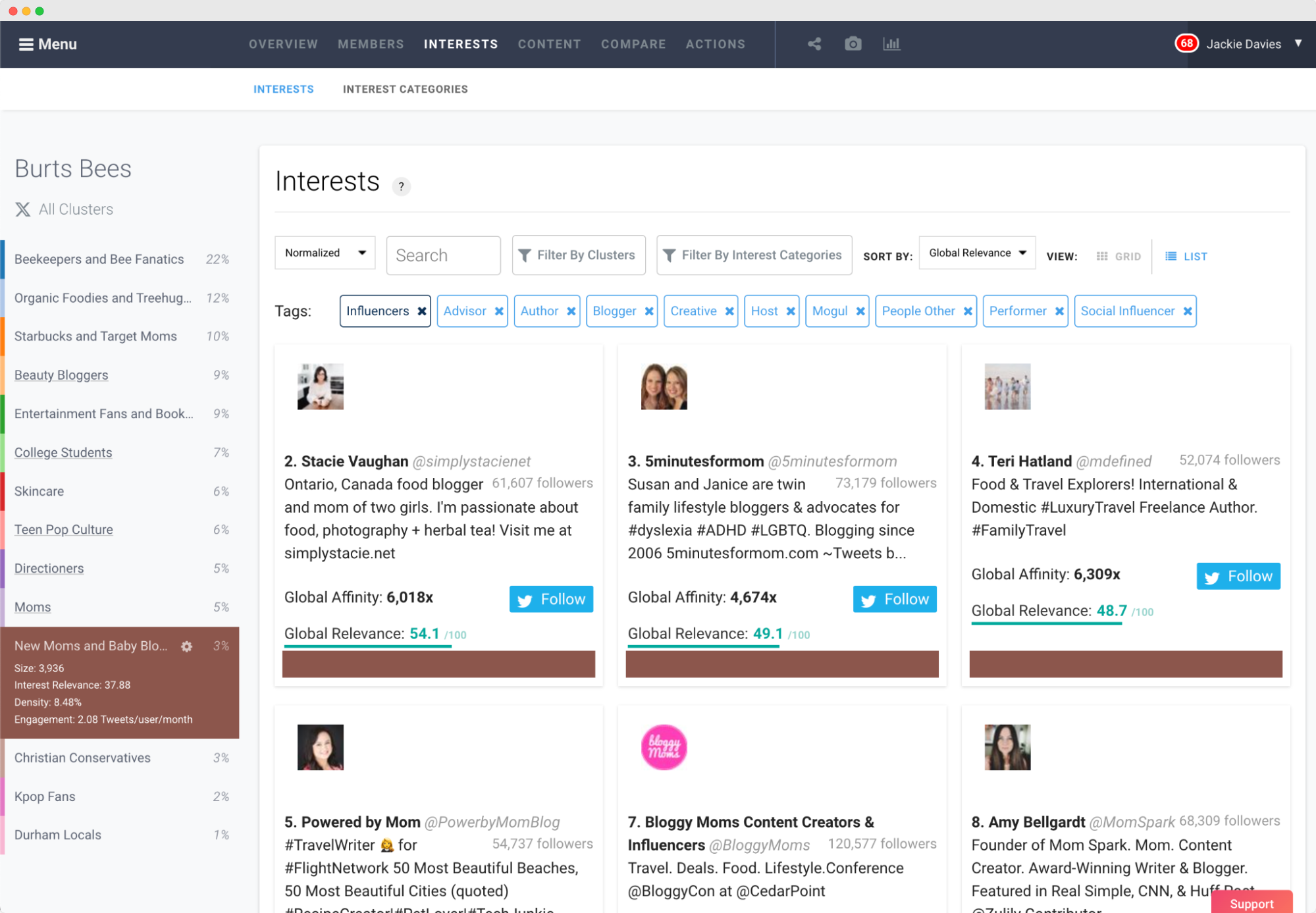
Step 5: Campaign planning
Now that you are familiar with this segment it’s time to focus on the insights that will help you build a successful campaign strategy.
Audiense reports outline the best ways to target audiences including which content resonates the most, which influencers to work with, and which media channels to place the most ad spend on.
For example, when referring to the Burt's Bees “New Moms and Baby Bloggers” segment, the insights tell us that this particular audience should be targeted through Pinterest ads, and through “Mommy Blogs” such as the @Mombloggersclub or @Momswhosave. The type of content that resonates most are blog posts about shopping guides and natural skincare routines. This audience is heavily influenced by bloggers Stacie Vanghan, 5minitesformom, and Teri Harland.
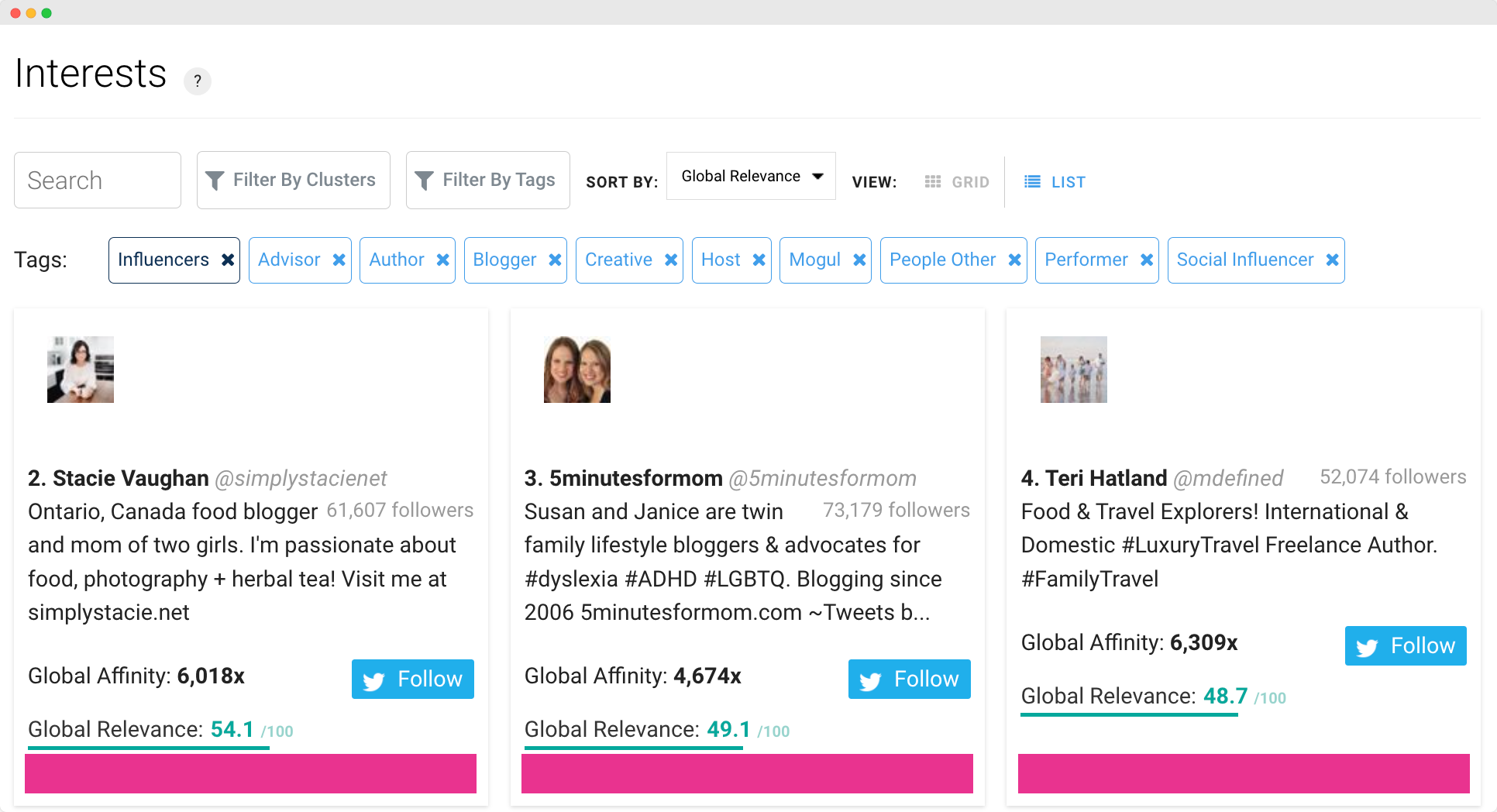
Step 6: Audience targeting (campaign execution)
Once the marketing strategy is implemented and the campaign is created it’s time to get it in front of the intended audience. The Audiense platform makes it easy to send exact audience lists straight to your ad account on social. This way you can ensure you are targeting the exact audience of your choice, and no ad spend is wasted.
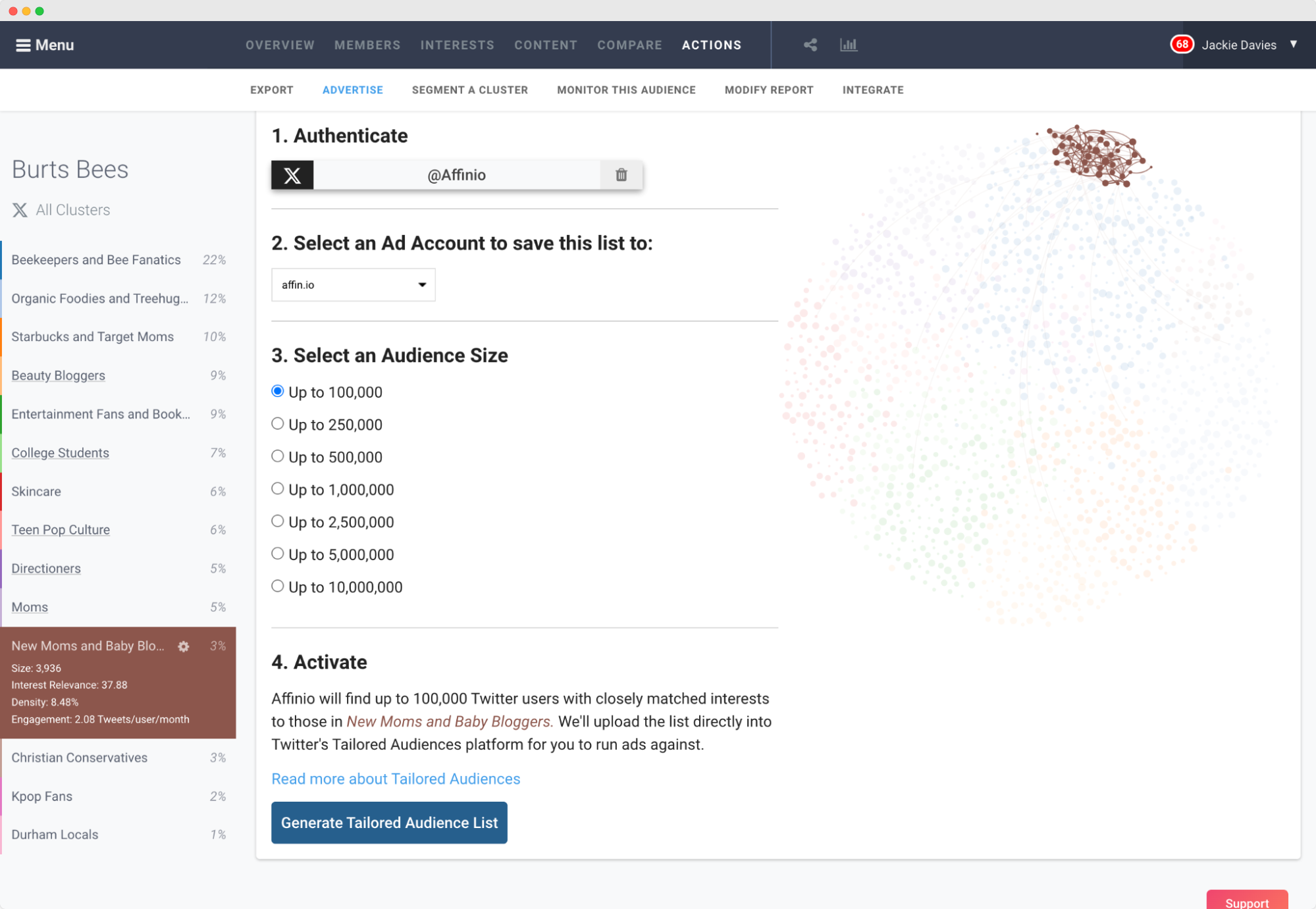
Implementing the steps above with the Audiense platform [case study]
Audiense customers use the platform to put the above steps into practice, and they drive real results through audience segmentation.
Banco Pichincha
Banco Pichincha, a leading Ecuadorian financial institution, wanted to target and engage with football fans through sponsorships. The problem they were facing was that the audiences they were currently targeting were too broad, and their sponsorship campaign engagement rates were low.
To solve this issue, Banco Pichincha decided to use the Audiense platform to segment the football fans audience into smaller more niche target groups based on their shared interests and affinities. Audiense unearthed many new and unexpected segments that had been ignored. Banco Pichincha dove into the Audiense report, and used the insights they had on each segment to create highly personalized campaigns for each.
The results were remarkable, and Banco Pichincha witnessed a tenfold increase in audience engagement just by refining their targeting and tailoring their marketing strategy to each segment. Overall the campaign led to more meaningful connections with their customers and fans because they chose to segment them with Audiense.
Sign up to segment your audience.
Customer testimonials
Audiense is one of the top audience segmentation tools used by agencies. Here’s what they have to say about the platform:
“Audiense is the first platform I look to whenever I'm working on an audience development project. The segmentation, comparisons, and global landscape make it perfect for projects, big or small. With my work focused primarily in the music industry, I'm able to easily find the artists I'm working with or comparable artists to start any project. The deep breakdowns across all the different forms of media, user preferences, demographics and more is the most robust offering I've seen and with the newest acquisitions expanding across additional social media sites, it really is an uncomparable project.” Christine Osazuwa, Chief Strategy Officer, Shoobs
“Their technology, their data, and their team exceptional. Audiense offers the most robust view of consumer behavior and personalities across social platforms – insights we cannot get anywhere else. We rely heavily on these observations for both clients and new business efforts. I LOVE the behavioral profile, the instant segmentation, and the media content consumption - it brings our media and strategy planning to the next level.” Jackie Mockridge Mattina, Head of Audience, Insights, and Planning, Accenture Song
“The segmentation - I've yet to find another tool that does this so well. Basically, once you set up an audience, Audiense will automatically create several segments based on their common affinities. This is incredibly useful from a marketing point of view as it gives you the tools you need to create truly targeted and personalized marketing and advertising campaigns: on social media, your blog, your content, even in print/TV and other offline mediums...pretty much anywhere you want to run a campaign. And in some cases, the segmentation can even help you new business opportunities that you might've otherwise missed.” Lilach Bullock, Digital & Tech Influencer
Segment your client’s audience now
In this competitive digital marketing era, success relies on audience segmentation to get audience targeting right the first time, and cut through all the other ad noise.
Audience segmentation, facilitated by tools like Audiense, ensures that campaigns resonate and no ad spend is wasted.
Unbiased segmentation uncovers new customer opportunities and enables personalized campaigns that drive higher ad engagement and ROI, and lead to client success.
Sign up for Audiense and segment your client’s audience today.





